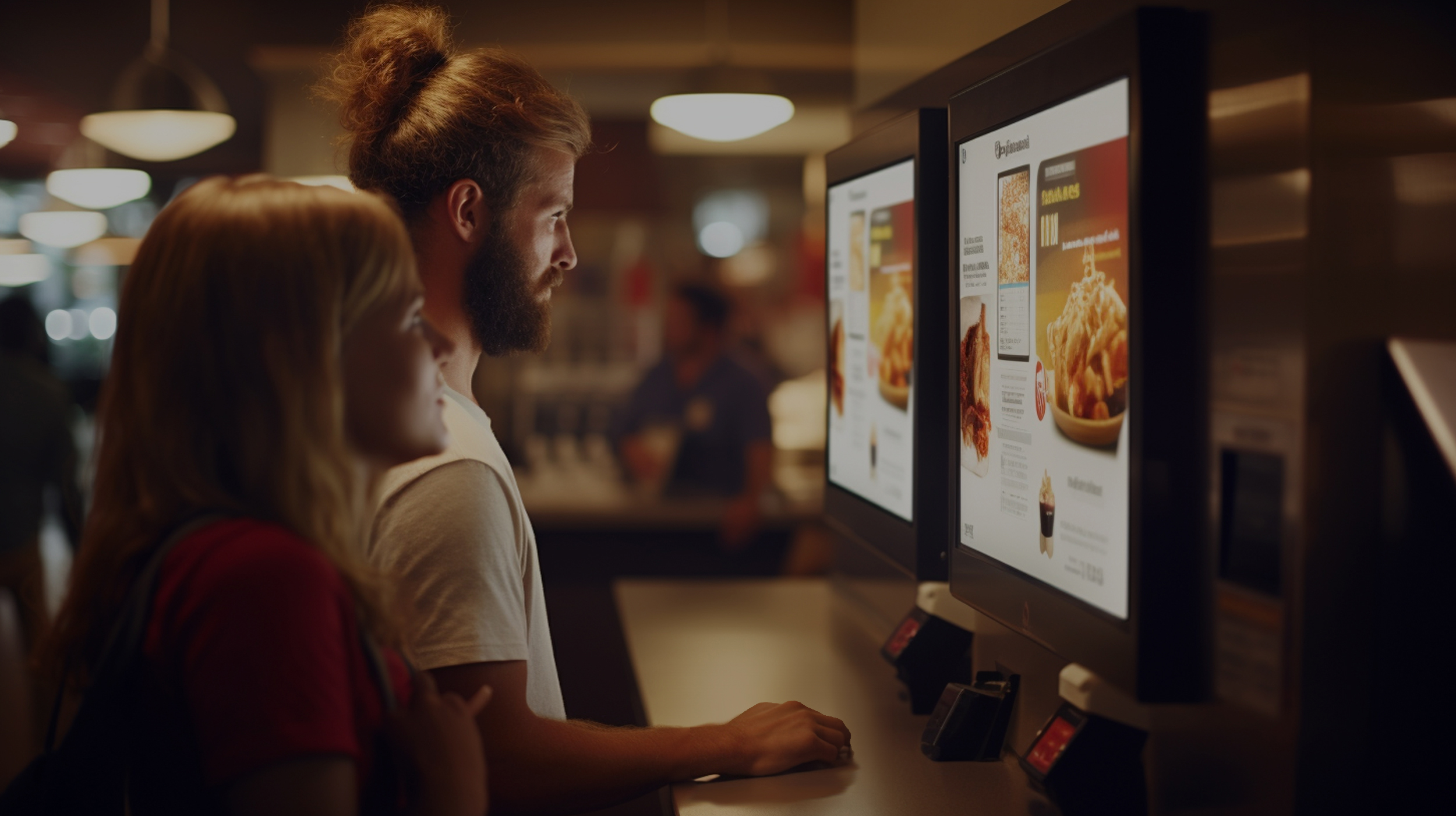If you walk into various coffee shops, fast-food restaurants, supermarkets, airports, or even banks today, a noticeable shift is apparent. Rather than being greeted by a smiling face or a human voice, you’ll likely be met with an array of self-service screens and kiosks.
This transformation didn't occur overnight. For some time now, we have been enticed by the allure of convenience, seamless experiences, and interactions that allow us the autonomy to make choices independently - or ‘Self-serve’. The proposition was that facilitating self-service touchpoints and expediting interactions would benefit businesses and increase the bottom line. This, in fact, holds true. Nearly a decade ago, as these screens began proliferating, research emerged suggesting that companies that reduced in-person customer service times by around 7 seconds could witness a 1-3% boost in their market share.
Evidence also illustrated that fast-food chains like McDonald's, who integrated digital kiosks, experienced an increase of 20-30% in customer order basket sizes on average.
The lure of convenience.
At face value, these advantages are difficult to dispute. Kiosks diminish waiting times, eliminate the need to hire staff for till management and order taking, mitigate decision-making pressure and self-consciousness for customers, offer an array of choices, and have been particularly favoured during the global pandemic from a public health perspective.
However, let's also consider the flip side of these advantages. As brand owners, we need to question whether what works for fast food retailers like McDonalds will work for us. And as designers, part of our responsibility is to craft experiences that enhance the lives of individuals and society as a whole.
Today, it's entirely possible for someone to minimise all human interaction throughout the day. From ticket purchases and navigating automated barriers on public transport, sitting amid a sea of individuals engrossed in screens on your commute, ordering coffee and lunch through touchscreen kiosks, grocery shopping via self-checkout in stores or on delivery apps—all of these can be executed devoid of substantial human interaction. It's convenient, isn't it? Yes, until we recognise that sometimes, human interaction is precisely the 'friction' we need in these instances.
From purely transactional to relational.
Contemporary digital interactions have the potential to be remarkably engaging and dynamic. Most people, for example, accept that purely digital desktop interactions such as ecommerce purchases don’t require interacting with real individuals, by their nature they are convenient at remote, and at home experiences. So when people are subject to screens outside the home in a service scenario with digital kiosk screens, should the same rationale apply? Perhaps, but it’s precisely this context that matters.
We can argue that when transactional moments transition entirely from humans to screens, especially in a real world service context, something is lost. When digital experiences dominate a physical world, things begin to feel somewhat sterile and soulless. We might expect this for a certain standard of fast food, where we don’t expect human connection but do we lose a vital part of brand personality when we all rush to the same standard of self-service?
As we ‘self-serve’ via transactional screens, it’s now not uncommon to see the real humans who we used to converse with, rushing in the background to swiftly deliver our food, perhaps only briefly interacting with us to shout out our names that we've just punched into a digital kiosk.
Even in scenarios such as coffee shops that do have a human barista, it doesn't take long for us to realise that they’re asking our names, not out of personal interest, rapport, or connection, but to make the process of delivering orders faster and more efficient. What’s going on here? Have we all become so repeatedly sold on efficiency and speed that we’re blind to see the real lack of value exchange? Have we become actual captives of convenience and automation?
Brett Scott’s recent article on technology and efficiency, highlighted this aspect perfectly, he explored how the touted efficiency of new technologies hasn't necessarily delivered the promised convenience. We haven't gained hours of free time from the saved seconds; instead, it's been filled with heightened productivity, and simply more stuff. Automation in many cases hasn't made life more convenient; it has merely accelerated its pace.
Human connection is synonymous with memorable, higher-value experiences.
The team at ZeroSixty have designed countless consumer experiences for both the mass market and higher value luxury experiences. With clients operating in the high-net-worth sectors it is a widely recognised belief that higher-touch, more human experiences, are considered more ‘luxury’, whereas heavily automated and transactional experiences are more ‘everyday’. This isn't purely because it costs more to employ humans, it's also largely because it signifies care, attention, uniqueness, and personalisation.
Enhancing efficiency and productivity for businesses is certainly a priority. Most design teams are rightfully tasked with addressing business challenges, primarily focused on increased revenue, optimisation, all under the umbrella of enhancing the customer experience. But is this the only goal we should strive for? And, does it have to be a binary outcome?
Stepping back and examining the net effects with a fresh perspective reveals the unintended consequences. We’ve seen self-service backfire in some banks, where digital interactions actually increased the demand for face-to-face interactions in branches. Similarly, self-checkouts have shown to continually frustrate users and in some cases create longer delays when purchases exceed a small number of items. Only recently we’ve seen some retailers such as Canadian Tires, some Walmart stores, and Booth’s in the UK abandon these in favour of more face-to-face connections with customers again.
Many of these self-serve experiences are also rightly called out for their lack of inclusivity of use. Perhaps the most insidious effect of all-digital physical experiences, however, is the gradual erosion of what makes experiences memorable—human interaction. When it’s these moments that often leave a lasting and differentiated impression of your brand, we think it needs concerted design consideration and effort.
Designing for social and relational value.
It’s important to clarify, not all entirely screen-based interactions are negative (we wouldn’t do what we do if that were the case). But it does feel like we’ve taken our collective eye off the ball. Emphasising experience and service design over a narrow technological and purely metric-centred viewpoint—is imperative. Through this examination of customer journeys and digital interactions, we can discern where to allow moments where humanity can shine through.
We should conscientiously deliberate how to design these moments and ensure that genuine human engagement augments digital interactions, culminating in a positive overall experience for the customer, the business, and the brand. Does this require a real human interaction for every screen-based touchpoint? No, but we can deliberately contemplate when to infuse human interaction, ensuring it transcends mere transactional engagement, by incorporating social and relational value too.
When we look at the millions of dollars being poured into AI chat bots, VR & AR today, we come to similar conclusions. Is having a digital replica of our favourite artists as holograms enough? Are we happy just to fake human interaction? Just as we’ve seen the harmful effects of mobile phone usage for young people, we believe - although perhaps not to the same extent - that an all screen-based physical shopping or entertainment experience will lead to worse outcomes in years to come for us individually and for society as a whole. This requires going beyond ‘spectacle’, ‘moments of delight’, and ‘novelty’.
So, how can a more considered design approach make a difference? It’s not without challenges. As the saying goes: those who design the ship also design the shipwreck. At ZeroSixty, we believe that with focused intent and a broader service perspective, we can design experiences that are both human and high-performing on a transactional level. At ZeroSixty we like to approach these challenges through a number of steps, but we also believe that pace creates space. Rapid iteration gives us the ability to be thoughtful about the effect of our design decisions. We create prototypes and boundary objects that make some of the unintended consequences more tangible earlier, often without the need of a very long or drawn out strategy stage. These steps include a deeper understanding of the specific user scenarios, a look at the cumulative emotional experience of use, not just a focus on ‘magic moments’ or ‘areas of delight’. Most importantly however, it also involves a ‘futures thinking’ perspective that enables us and our clients the opportunity to look at what the best or worst consequences of the big design and business decisions in our iterations are.
Of course, none of these aspects are facile, and they demand a deeper reevaluation of our preconceived notions of what success looks like. If we undertake this reassessment with craftsmanship, care, and just a sprinkling of genuine humanity—beyond branding frivolity—we’re confident that these are the experiences that we’ll remember for being more enriching and fulfilling from a user perspective, and more successful from a business perspective as a result.




